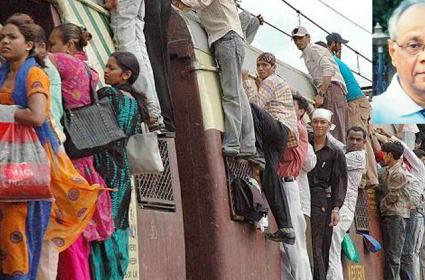Mumbai’s Lifeline With Too Many ‘Riders’

Mahesh Vijapurkar
Mumbai's local trains carry a mind boggling 75 lakh people every working day and is rightly called the city's lifeline. It connects distant suburbs like Karjat, Kasara, Virar to the city's core business areas.
If their operations are halted, which is a strategy of the Shiv Sena, it is a bandh. The city comes to a halt, and even the compulsive commuter agrees to stay home. Thus bandhs do not voluntarily find participation, people are forced to stay home.
A train every three minutes on an average, a halt at stations of under a minute, a combination of fast - that is something which doesn't stop at all stations - and slow, picking up passengers from all of them - provides certainty of travel though not comfort.
The shove and the push to get a toehold is a daily crisis to overcome. You need to wait for passengers to disembark before you try to gain access to standing room. Long sufferers politely call the duration of travel "body massage" whereas it is inadvertent molestation.
It is not that the two systems, Central and Western are not doing enough. They have added new rakes, increased frequencies, and converted the nine-coach locals to 12-coach, and they would all be of 15 cars in not so distant a future.
When tracks are available for maintenance between 1am and 4am, and parts of tracks are taken up for it on Sundays, calling them megablocks, it is clear railways are up against it. In a manner of speaking, it's like performing a cardiac surgery on a beating heart.
However, this lifeline also takes lives. On an average, some 3,000 die either by falling off running trains by losing the precarious hold they manage, or bring hit by a pole by the side of the tracks, or by asphyxiation. The four to five times of designed capacity helps reduction in oxygen availability.
The other cause is people crossing the tracks, despite knowing the risks. The other day, a stationmaster crossing over to investigate such one trespass was run-over. In 2010, as many as 40 railway employees lost their lives in the line of their duties. Trespassing is not entirely railway-induced.
During peak hours - which is extending, actually, commuters find the foot over bridges so crowded, some foolishly take the chance by trying to cross the tracks. That's when more trains run on the tracks per hour. A slight misjudgement could mean bidding goodbye to one's own life.
These about ten deaths a day, said to be half of those on the entire railway system across the country doesn't cause a ripple except a brief notice in the papers and sometimes a compilation of statistics across a timeline. It is as routine as a politician's sneeze for a statement.
There's the other reason why people die and it's the gap between the foot board and the platform, sufficient to swallow a person. This is being progressively corrected with Bombay High Court having had to order it. This is surprising because trains have to meet safety parameters and distance between the two was ignored.
Huge funds are being deployed to improve the cheapest mode of transport in the Mumbai metropolitan region, but the demand-supply gap, in favor of demand, remains. Metros, monos, are being built but it's waking up late.
Inadequacy of cheap, and discomfort of commute is forcing people to take to cars. That, in turn, is forcing resources being diverted to private, and polluting transport. Mumbai's roads are already gridlocked, and the city has little space. It has to encroach the sea.













